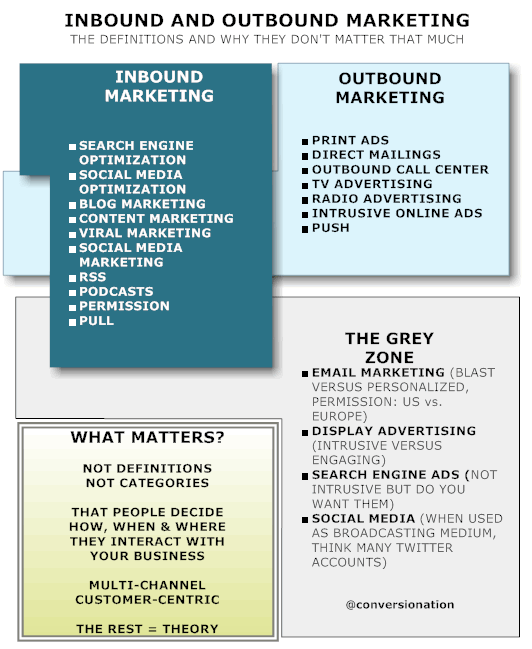
Since several years marketers are debating the evolution of marketing from the inbound marketing versus “outbound” perspective. Inbound marketing is defined as all forms of (mostly digital) marketing whereby people “find” your company/products/services and that includes tactics and channels such as social media marketing, SEO, SEA, blog marketing and content marketing.
Outbound marketing is basically what we once used to call “push marketing”: direct mail, telemarketing, trade shows, etc. In the US, email marketing is often considered as “outbound” but as HubSpot’s Mike Volpe told me at a conference, his company, that really “owns” the term inbound marketing, defines email marketing as outbound if it’s not permission-based.
Personally, I think there is no other form of email marketing. If it’s not opt-in, it’s not email marketing. Period.
This distinction between inbound marketing and outbound marketing is constantly put in the spotlight by hammering on the growing importance of “inbound” compared to the stagnation of “outbound”. And, yes, indeed, the budgets that are invested in social media marketing, content marketing and other forms of inbound marketing continue to grow significantly while many “outbound” channels and methods stagnate or grow slower.
Marketing thinking is often black and white: the customer reality is not
The distinction between “inbound” and “outbound” is really an artificial and meaningless one and maintained primarily by businesses that make a living doing “inbound”. It is also proof of black and white thinking (as is always the case in “A” versus “B” debates).
However, we must realize that no form of marketing can be attributed to any of these artificial concepts, that are really more often overlapping than not. Social media are also used to generate traffic in a push way, to give just one example.
I could give more examples but that’s not really the debate. People do not think in those terms of inbound and outbound, only marketers. Consumers (and we all are) have a very complex, far from linear, life and buying cycle. Media behavior, communication behaviour and information gathering processes are not linear either. They increasingly move online and become fragmented but that’s the only certainty and we tend to forget all too often offline interactions.

Getting rid of media and channel centric thinking: customer-centricity is media agnostic
In practice, people find companies or products not just by blogs, social media and tutti quanti. They find them through advertisements, promotional mailings and TV advertising as well. It’s the journey and mix that matter, not the medium.
Of course, for marketing theories and reports on changing behavior and shifting marketing spend, it can be useful to focus on some specific channels or categories that we have introduced such as inbound and outbound. However, the consumer couldn’t care less and communication, information gathering and buying behavior all raise above these categorizations.
What matters for a consumer is that the way he gets approached and is “invited” (directly by a message or indirectly by content, for instance) is contextually meaningful, appealing and adapted to what he wants here and now through a combination of channels that is adapted to his behavior and preferences.
The big problem with the antithesis of “inbound” and “outbound” is that it starts from a medium and message viewpoint instead of from a customer-centric one. Customer-centricity is what matters most in the way we market and do business. Companies that fail at working in a customer-centric way, also fail in collaborating and moving outside the old-fashioned silos and away from territorial behaviour, leading to confusing brand messages, a lack of consistency and message-centric thinking. They are blinded by the here and now, focus on what has always worked and grow at a slower pace (if at all) than organizations that do know how to overcome the individual urgencies and priorities of departments.
All this being said, below is an infographic from US-based mdg advertising for those who like to talk about inbound versus outbound (and it does contain some interesting data) or the statistics’ lovers. Most data in it come from HubSpot, as said almost considered as the “inventors” of the concept of inbound marketing.


